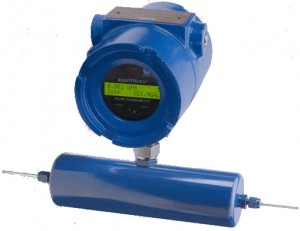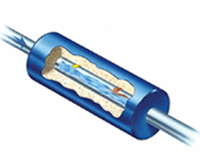

- Low Flow Liquid Meters
- Low Flow Gas Meters
- Duct Flow Meters for Air & Gas
- Low Flow Controller
- MaxExtractor Extraction Monitor
- Multi-Variable Process Meter
- Bidirectional Flow Meters
- RheoVac® Multisensor Flow Monitors
- Flow Switches
- Custom Process Measurement
- Instruments for Hazardous Locations
- Electronics Options
Low Flow Liquid Meters
Rheotherm flow meters are an excellent—often the only—choice for reliable liquid flow measurement at low flow rates. For flow rates from 1 gallon/year (10 cc/day) to a few GPM, they provide repeatable fluid flow measurement with little or no maintenance. Options for hazardous locations (intrinsically safe/NEMA 7 explosion-proof) are also available for low flow meters from Bionetics, a leader in manufacturing flow monitoring devices since 1978. All of our Rheotherm flow instruments are backed by an ISO-9001:2015 certified Quality Assurance program.

What Can Our Liquid Flow Meters Measure?
The Rheotherm Model 210 flow meter can be used to measure continuous flow of most homogeneous liquids with low or high viscosity, as well as slurries. The unique design of our inline sensors provides an unobstructed flow path and is available in a variety of materials for compatibility with most fluids. Our inline flow meters have been used to measure everything from liquefied gases to thick oils and pastes, corrosive chemicals, light hydrocarbons, water and water-based fluids. Chemicals that can be accurately measured by Rheotherm low volume liquid flow meters include the following:
- Liquid chlorine
- Antifoam
- Aluminum sulfate
- Polymer
- Biocide
- Magnesium oxide
- Magnesium sulfate
- Magnesium sulfonate
- Sodium hypochlorite (NaOCl)
- Hydrofluorosilicic acid (HFSA)
- Ferric chloride (FeCl3)
- Sodium hydroxide (NaOH)
Check out our complete list of applications.
Their versatility in flow rate measurement capabilities have made these thermal flow meters valuable monitoring tools in a broad range of industries, including but not limited to the following:
- Chemical/Petrochemical
- Aerospace
- Natural Gas
- Oil & Gas Production
- Wastewater Treatment
- Pulp & Paper
- Nuclear
Visit our Industries Served page for more information about many of the industries and applications that Bionetics has served.
How Are They Installed?
Rheotherm flow meters incorporate inline flow sensors typically installed with standard tube fittings, but optionally available with flanges, sanitary fittings, etc. Any orientation is acceptable, except vertical with downward flow direction. With some models the electronics are integral to the sensor. Other models have a separate electronics enclosure that can be installed up to 200 feet from the sensor; this option is especially helpful in environments where space is restricted. For hazardous environments, it is advisable to select FM approved intrinsically safe sensors and/or FM/cFM approved explosion-proof integral units. Electronics Options
What Is the Turndown Ratio?
Typical calibration ranges are 10:1 (options up to 200:1), with good accuracy over the entire range. The sensors cannot be damaged by over-ranging.
How Do They Work?
 Like all thermal flow meters, the Model 210 analyzes the thermal properties of fluid as it passes through the device to determine the accurate fluid flow rate. Our inline low flow meters use either a straight-through or looped flow tube with two Resistance Temperature Detectors (RTDs)—one heated, the other unheated—attached to the outside of the tube. The temperature differential between the two RTDs provides the primary flow signal. At high flow rates the differential is lower as flow removes heat more readily. At low flow rates the differential is higher because less heat is removed. Because the liquid flows continuously and its composition is homogenous, an accurate flow measurement can be made without the need to gauge the pressure of the fluid.
Like all thermal flow meters, the Model 210 analyzes the thermal properties of fluid as it passes through the device to determine the accurate fluid flow rate. Our inline low flow meters use either a straight-through or looped flow tube with two Resistance Temperature Detectors (RTDs)—one heated, the other unheated—attached to the outside of the tube. The temperature differential between the two RTDs provides the primary flow signal. At high flow rates the differential is lower as flow removes heat more readily. At low flow rates the differential is higher because less heat is removed. Because the liquid flows continuously and its composition is homogenous, an accurate flow measurement can be made without the need to gauge the pressure of the fluid.
The unobstructed fluid path ensures that nothing touches the fluid except the flow tube wall, and there are no mechanical parts to wear, stick, or break. The presence of solids in the fluid will not damage the sensor. The Rheotherm Model 210 flow meter comes standard with no local display, however, you have the option of selecting a 2 x 16 backlit LCD display that shows the mass/volume flow rate, the temperature (°C or °F), and the total accumulated flow. Flow data can be generated in analog and digital form, and then routed to a digital display or an off-site computer.
The Model 210 also includes a self-diagnostic feature that automatically detects system problems and generates fault codes which can be viewed by the user.
More on the Rheotherm Method of Operation (PDF)
How Do I Get One?
Contact one of our flow application specialists using the form on this page to configure a Rheotherm flow meter tailored to your application. You can also download and complete the Flow Application Data Sheet and email it to us at sales-flow@bionetics.com.
For other questions and ways to reach us, visit our Contact Us page for telephone, fax and email information.
- No moving parts
- Exclusive inline TU sensor
- Advanced signal processing electronics
- Field adjustable; easy onsite calibration adjustments
- Maintenance-free
- Easy installation
- Choice of wetted materials
- Long-term reliability
- Stores up to four calibration curves
- Extended temperature compensation
- Optional remote electronics configuration
- Hazardous environment options
| Standard | Options | |
| Temperature | Process: 0 – 140°F (-18 – 60°C) Environment: 0 – 120°F (-18 – 50°C) |
-20 – 350°F (-30 – 175°C) |
| Pressure | 0 – 1,000 PSI | Up to 30,000 PSI |
| Calibration Ranges | – 10:1 Turndown – 0.007 cc/min to 20 GPM |
– Up to 200:1 turndown; – Four calibration channels available (for multiple flow ranges or fluids using the same sensor) |
| Calibration Accuracy | ± 1% of reading typical | |
| Response Time | 1 sec. ; 3 – 5 sec. typ. (63% of range) |
Time constant/delay option |
| Repeatability | ± 0.5% of reading | |
| Standard | Options | |
| Line Sizes (flow range dependent) |
Capillary; 1/16”; 1/8”; 3/16”; 1/4”; 3/8”; 1/2”: 5/8”; 3/4”; 1” |
Other sizes via fittings/adapters |
| Process Connection | Plain tube stubs suitable for compression fittings | – MNPT: – Tri-Clover (Sanitary); – SS Flange (1/2″ – 2″); Most other fittings available |
| Wetted Material | 316 SS | – Hastelloy C-276®; – Monel®; – Alloy 20; – Titanium; – Tantalum; – Inconel |
| Display | 2 X16 backlit LCD with selectable display of: – Mass/volume flow rate – temperature – total accumulated flow |
|
| Standard | Options | |
| Enclosure | Sensor: PVC Integrated Electronics: NEMA 4X Cast Aluminum Remote Electronics: NEMA 4 |
Sensor: Stainless steel Remote electronics: – Stainless steel – NEMA 7 Explosion-proof |
| Hazardous Environment | Integrated electronics FM-Approved for: – Class I, Div. 1, Groups B,C,D – Class I, Zone 1, IIB+H2 (US) – Class II, Div. 1, Groups E, F, G – Class III, Div. 1 Remote electronics: Same as above except addition of Group A using ISB |
|
| Outputs | 4 – 20 mA (flow rate) or Serial Burst with Flow Rate, Totalizer, and Fluid Temperature | – 0 – 10 or 0 – 5 VDC; – Pulse (5 VDC open collector); – HART (4-20 mA) ; – SPDT relay; – 4 to 20 mA temp |
| Input Power | 24 VDC ±4V (200 mA – blind unit; 300 mA w/display option) |
110/230 VAC ±10V |
Inline Sensor Flow Capacities for Liquids
| TUBE SIZE | ||||||||||
| FLOW RATE LIMITS | C | 1/16 | 1/8 | 3/16 | 1/4 | 3/8 | 1/2 | 5/8* | 3/4* | 1* |
| Extended Maximum | 2 | 60 | 500 | 0.4 | 1 | 2.5 | 4.6 | 8 | 10 | 20 |
| Normal Maximum | 1 | 30 | 250 | 0.25 | 0.5 | 1 | 2 | 3.5 | 4.5 | 8 |
| Normal Minimum | 0.03 | 0.8 | 6 | 0.008 | 0.01 | 0.03 | 0.05 | 0.2 | 0.3 | 0.5 |
| Extended Minimum | 0.007 | 0.05 | 3 | 0.002 | 0.006 | 0.01 | 0.02 | 0.07 | 0.1 | 0.2 |
| cc/min | GPM | |||||||||
*Limited applications. Consult Factory



